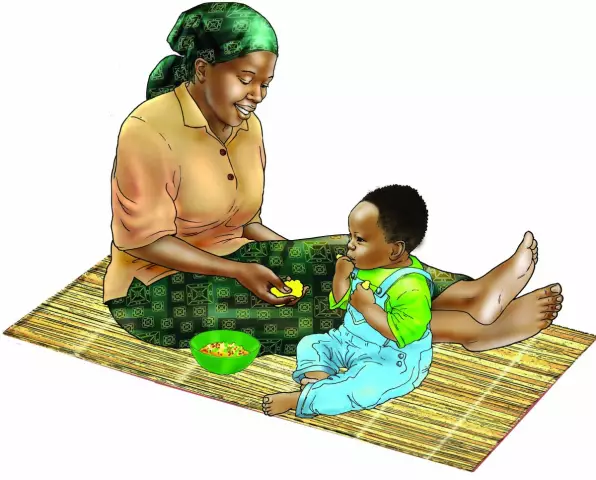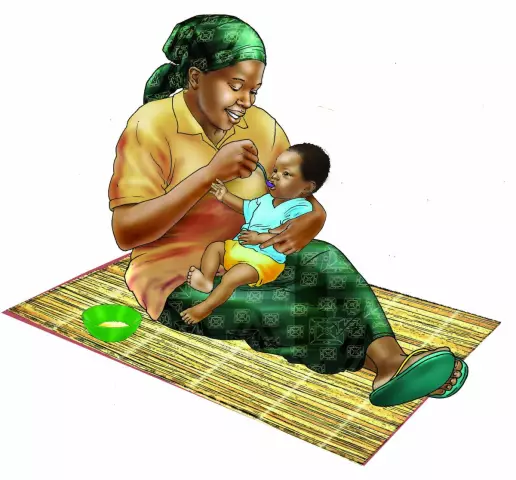- Author Rachel Wainwright [email protected].
- Public 2023-12-15 07:39.
- Last modified 2025-11-02 20:14.
Complementary feeding of a child at 6 months
Complementary food for a 6 month old baby is an additional type of food. In taste, composition, consistency and form of introduction, complementary foods are significantly different from breast milk.
Rules for introducing complementary foods to a 6 month old baby
Complementary feeding stimulates the development of the chewing apparatus, trains the digestive system to take food other than matter milk, prepares for independent feeding.

There are certain rules for introducing complementary foods for a 6 month old baby:
- Complementary foods are introduced sequentially, in turn, a new type of food is given only when the previous dish has already been introduced in full;
- A new type of nutrition should be introduced only against the background of the child's full health;
- The consistency of complementary foods for a 6 month old baby should be homogeneous, semi-liquid, so that the baby can easily swallow food;
- Complementary foods should be warm, given with a spoon, while the child should sit;
- Feeding begins with complementary foods and only after that breastfeeding is offered to the baby;
- The maximum amount of complementary foods for a child in the first half of life is 150 g, for the second - 180 g; begin to give complementary foods with 1 teaspoon (5 g), gradually bringing up to full volume over 2 weeks.
- It is better not to give two liquid or two thick meals of complementary foods in one feeding; it is also not recommended to give one type of complementary foods twice a day;
- The mother should observe the child's stool after the introduction of complementary foods - if it has not changed, then the baby tolerates the new dish well, and its volume can be increased further;
- New complementary foods should not be introduced on the day of the vaccination.
Types of complementary foods for a baby 6 months old
On artificial and mixed feeding, the first complementary foods can be introduced as early as 5 months. When feeding only with breast milk, according to WHO recommendations, the first complementary foods are introduced at the age of 6 months.
The first complementary foods for a 6 month old baby can be:
- Vegetable puree;
- Cereal porridge.
What complementary foods to give first depends on the child. If he is gaining weight well, or the baby has a tendency to constipation, then it is recommended to start with vegetable puree. When the child does not gain enough weight, as well as in the absence of constipation, porridge can be introduced.
Porridge as complementary food
Porridge is usually served with breakfast. Add 3-5 g of butter to it. Cereal-based cereals are usually liked by children, there are no problems with their introduction. The first porridge, which will serve as complementary food for a 6 month old baby, should be prepared from one type of cereal. The meal must be gluten-free (a cereal protein that causes celiac disease or gluten allergy). Suitable gluten-free cereals include:
- Rice;
- Buckwheat;
- Corn.
Gluten is found in wheat, from which semolina and wheat groats are made, in barley and oats. It is better to introduce porridges from these cereals later (semolina porridge - in the second year of life). The first porridge is prepared in water, diluted mixture or breast milk. Cow's milk can cause allergies in a child, so it is approved for use only after 1 year. Cereals based on breast milk and cow's milk have great biological value.
To get acquainted with cereals for the first time, the baby should prepare buckwheat or rice dairy-free cereals. After 2-3 months, it will be possible to include multi-grain cereals or cereals with additives in the diet.
As a complementary food for a child of 6 months, it is convenient to use children's instant cereals, offered in a huge assortment by various manufacturers. Their choice should be approached, guided by the above principles and advice from pediatricians.
Vegetable puree as complementary food
If complementary foods start with vegetables, then their type is selected especially carefully. The first vegetables on the baby's menu should:
- Contain delicate fiber;
- Grow up in the region where the child lives;
- Be environmentally friendly;
- Do not cause allergies.
An ideal option for the first child in the life of a vegetable puree - zucchini or cauliflower. They are well digested and do not cause excessive gas formation.
Later it will be possible to introduce vegetables such as carrots, pumpkin, broccoli, potatoes, cabbage, turnips into the diet, and also mix 2-3 components in one dish.

The consistency of the vegetable puree should be homogeneous so that the baby can easily swallow it. 1 teaspoon of vegetable sunflower oil is usually added to puree.
The child's stool after the introduction of complementary foods in the form of vegetable puree becomes regular, this is especially noticeable if he previously had a tendency to constipation. Vegetables are a valuable source of fiber for bowel cleansing and are also rich in vitamins and minerals.
Cottage cheese - complementary food for a baby 6 months
In the middle of the seventh month, you can already introduce cottage cheese. This fermented milk product is rich in calcium, which is so necessary for the baby to grow bones and teeth. It is not recommended to introduce cottage cheese earlier than 6.5 months, as it places an increased load on the baby's excretion system.
In 2 weeks, the first complementary food (vegetable puree or porridge) will be introduced in full, after which you can start giving the child cottage cheese. On the first day, one teaspoon of this product should be offered, day after day, its amount is gradually increased, bringing it to 40 g by 7 months. For children of the first year of life, it is good to use specialized baby cottage cheese, which is well adapted to the child's gastrointestinal tract. This curd can be purchased in the dairy kitchen or in baby food departments.
On a jar of cottage cheese there should be an indication that the product is allowed to be given from 6 months. You should also pay attention to the shelf life of the product - for baby curd, it does not exceed 14 days.
Found a mistake in the text? Select it and press Ctrl + Enter.






